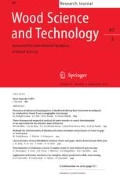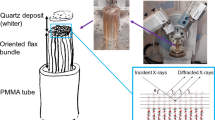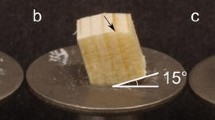Summary
It is the fibrillar orientation in the S2-layer which to a great extent determines the mechanical properties of the wood fibre, with regard both to strength and stiffness and to swelling properties. Measurements of the average fibril angle of fibres are not however easy and the results differ between the methods used. In order to evaluate in more detail how the fibril angle varies in spruce wood, an X-ray method based on diffraction from the 040-plane was developed. By comparison with microscopic examination it is concluded that reliable results relating to the fibrillar orientation in the S2-layer are obtained with the X-ray technique. It is shown that the fibril angle of mature wood is rather constant with regard to both age of the annual ring and its position in the height of the tree. The fibril angle of the earlywood is found to be only slightly higher than that of latewood fibres. It is also shown that compression wood may be easily identified by virtue of the fact that its fibril angle is much higher than that of normal mature wood.
Similar content being viewed by others
References
Atmer, B.; Thörnqvist, T. T. 1982: The properties of tracheids in spruce (Picea abies Karst.) and pine (Pinus silvestris L.). The Swedish University of Agricultural Sciences
Boyd, J. D. 1977: Interpretation of X-ray diffractograms of wood for assessments of microfibril angles in fibre cell walls. Wood Sci. Technol. 11: 93–114
Cave, I. D. 1966: Theory of X-ray measurements of microfibril angle in wood. Forest Prod. J. 16(10): 37–42
Cave, I. D. 1969: The longitudinal Young's modulus ofPinus Radiata. Wood Sci. Technol. 3: 40–48
Crosby, C. M.;Mark, R. E. 1974: Precise S2 angle determination in pulp fibres. Sv. Papperstidn. 77(17): 636–642
Dadswell, H. E. 1958: Wood structure variations occurring during tree growth and their influence on properties. J. Inst. Wood Sci. 1: 11–32
Echols, R. M. 1955: Linear relationships of fibrillar angle to tracheid length and the genetic control of tracheid length in slash pine. Tropical Woods 102: 11–22
Kantola, M.; Seitsonen, S. 1969: On the relation between tracheid length and microfibril orientation measured by X-ray diffraction in conifer wood. Annales Academiae Scientiarum Fennicae A VI Physica
Kyrkjeeide, P. A. 1990: A wood quality study of suppressed, intermediate and dominate trees of plantation grownPicea abies. Forest Products Laboratory, Madison, WI, USA
Lotfy, M.;El-osta, A.;Kellog, R. M.;Foschi, R. 0.;Butters, R. G. (1973): A direct x-ray technique for measuring microfibril angle. Wood Fibre 5(2): 118–128
Marton, R.; McGovern, S. D. 1970: Relation of crystallite dimensions of fibrillar orientation to fiber properties, in The physics and chemistry of wood pulp fibres. Tappi stap No 8: p. 153–158
Meylan, B. A. 1967: Measurement of microfibril angle by X-ray diffraction. Forest Prod. J. 17(5): 51–58
Meylan, B. A. 1968: Cause of high longitudinal shrinkage in wood. Forest Prod. J. 18(4): 7578
Ollinmaa, P. J. 1961: Reaktiopuututkimuksia. Acta Forestalia Fennica, Vol. 72. Society of Forestry, Finland
Oscarsson, A.; Sahlberg, U. 1993: Natural fibre textures in a naturally textured material. Proc. ICOTOU 10, Clausthal, Germany: p. 1463–1468
Page, D. H.;El-Hosseiny, F. 1983: The mechanical properties of single wood pulp fibres. Part VI, Fibril angle and the shape of the stress-strain curve. J. Pulp Pap. Sci., Trans Techn Sect. 9(4): TR 99–100
Paakkari, T.;Serimaa, R. 1984: A study of the structure of wood cells by X-ray diffraction. Wood Sci. Technol. 18: 79–85
Shultz, L. G. 1949: A direct method of determining preferred orientation of a flat reflection sample using a geiger counter X-ray spectrometer. J. Appl. Phys. 20: 1030–1033
Stuart, S.-A. Evans, R. 1995: X-ray diffraction estimation of the microfibril angle variation in eucalypt wood. Appita 48(3): 197–200
Tanaka, F.;Koshijima, T. 1984: Orientation distributions of cellulose crystallites in Pinus densiflora woods. Wood Sci. Technol. 18: 177–186
Wardrop, A. B. 1951: Cell wall organization and properties of the xylem. Aust. J. Sci. Res. Series B., Biol. Sci. 4: 391–414
Author information
Authors and Affiliations
Additional information
The authors thank Ms Ulla Jonsson for the microscopic measurements and Dr Anthony Bristow for the linguistic revision
Rights and permissions
About this article
Cite this article
Sahlberg, U., Salmén, L. & Oscarsson, A. The fibrillar orientation in the S2-layer of wood fibres as determined by X-ray diffraction analysis. Wood Sci.Technol. 31, 77–86 (1997). https://doi.org/10.1007/BF00705923
Received:
Issue Date:
DOI: https://doi.org/10.1007/BF00705923




